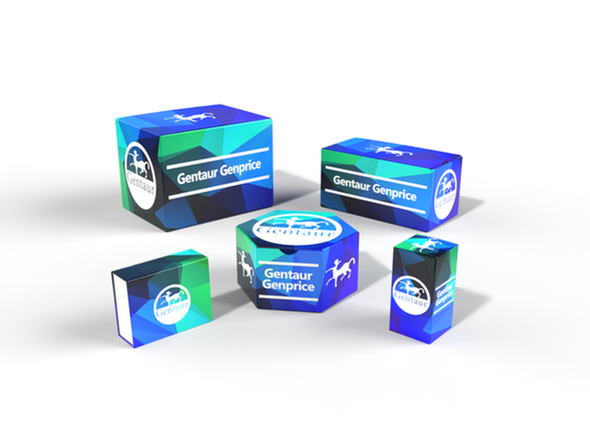Description
beta-Catenin Antibody | 33-117 | Gentaur UK, US & Europe Distribution
Host: Rabbit
Reactivity: Human, Mouse
Homology: N/A
Immunogen: A synthetic peptide from the middle of beta-Catenin / p120 protein was used as the immunogen.
Research Area: Cancer, Neuroscience, Signal Transduction
Tested Application: WB, Flow, IF, IHC
Application: Flow Cytometry: 0.5-1 ug/million cells
IF: 1-2 ug/ml
WB: 0.5-1 ug/ml
IHC (FFPE) : 1-2 ug/ml for 30 minutes at RT (1)
The concentration stated for each application is a general starting point. Variations in protocols, secondaries and substrates may require the antibody to be titered up or down for optimal performance.
1. Staining of formalin-fixed tissues requires boiling tissue sections in 1mM EDTA, pH 9.0, for 10-20 min followed by cooling at RT for 20 minutes.
2. The prediluted format is supplied in a dropper bottle and is optimized for use in IHC. After epitope retrieval step (if required) , drip mAb solution onto the tissue section and incubate at RT for 30 min.
Specificiy: N/A
Positive Control 1: N/A
Positive Control 2: N/A
Positive Control 3: N/A
Positive Control 4: N/A
Positive Control 5: N/A
Positive Control 6: N/A
Molecular Weight: N/A
Validation: N/A
Isoform: N/A
Purification: Protein A affinity chromatography
Clonality: Polyclonal
Clone: N/A
Isotype: IgG
Conjugate: Unconjugated
Physical State: Liquid
Buffer: PBS with 0.1 mg/ml BSA and 0.05% sodium azide
Concentration: 0.2 mg/mL
Storage Condition: Aliquot and Store at 2-8˚C. Avoid freez-thaw cycles.
Alternate Name: Catenin beta-1, Beta-catenin, CTNNB1, CTNNB
User Note: Optimal dilutions for each application to be determined by the researcher
BACKGROUND: Beta-catenin associates with the cytoplasmic portion of E-cadherin, which is necessary for the function of E-cadherin as an adhesion molecule. In normal tissues, beta-catenin is localized to the membrane of epithelial cells, consistent with its role in the cell adhesion complex. In breast ductal neoplasia, it is usually localized in cellular membranes. However, in lobular neoplasia, a marked redistribution throughout the cytoplasm results in a diffuse cytoplasmic pattern. Staining with beta-catenin antibody and E-cadherin antibody helps in the accurate identification of ductal and lobular neoplasms, including a distinction between low-grade ductal carcinoma in situ (DCIS) and lobular carcinoma. Additionally, some rectal and gastric adenocarcinomas demonstrate diffuse cytoplasmic staining and a lack of membranous staining, mimicking the staining pattern observed with lobular breast carcinomas.


![Beta Catenin Antibody [5H10] Beta Catenin Antibody [5H10]](https://cdn11.bigcommerce.com/s-1rdwiq712m/images/stencil/590x590/products/483865/489694/gentaur-genprice__26005.1661610467__29809.1661628092__75433.1661676199__77988.1661684280__64362.1661692443__02085.1662049603__45075.1662119302__91744.1662191540__21580.1662291419__55971.1663498780.png?c=1)
![Beta Catenin Antibody [12F7] Beta Catenin Antibody [12F7]](https://cdn11.bigcommerce.com/s-1rdwiq712m/images/stencil/590x590/products/483836/489665/gentaur-genprice__26005.1661610467__29809.1661628092__75433.1661676199__77988.1661684280__64362.1661692443__02085.1662049603__45075.1662119302__91744.1662191540__21580.1662291419__43445.1663498775.png?c=1)
![Beta Catenin Antibody [15B8] Beta Catenin Antibody [15B8]](https://cdn11.bigcommerce.com/s-1rdwiq712m/images/stencil/590x590/products/483864/489693/gentaur-genprice__26005.1661610467__29809.1661628092__75433.1661676199__77988.1661684280__64362.1661692443__02085.1662049603__45075.1662119302__91744.1662191540__21580.1662291419__77346.1663498780.png?c=1)
![Beta Catenin Antibody [6F9] Beta Catenin Antibody [6F9]](https://cdn11.bigcommerce.com/s-1rdwiq712m/images/stencil/590x590/products/483866/489695/gentaur-genprice__26005.1661610467__29809.1661628092__75433.1661676199__77988.1661684280__64362.1661692443__02085.1662049603__45075.1662119302__91744.1662191540__21580.1662291419__06584.1663498780.png?c=1)

![Beta Catenin Antibody [CTNNB1/1507] Beta Catenin Antibody [CTNNB1/1507]](https://cdn11.bigcommerce.com/s-1rdwiq712m/images/stencil/590x590/products/483859/489688/gentaur-genprice__26005.1661610467__29809.1661628092__75433.1661676199__77988.1661684280__64362.1661692443__02085.1662049603__45075.1662119302__91744.1662191540__21580.1662291419__23500.1663498779.png?c=1)
![Beta Catenin Antibody [CTNNB1/1509] Beta Catenin Antibody [CTNNB1/1509]](https://cdn11.bigcommerce.com/s-1rdwiq712m/images/stencil/590x590/products/483861/489690/gentaur-genprice__26005.1661610467__29809.1661628092__75433.1661676199__77988.1661684280__64362.1661692443__02085.1662049603__45075.1662119302__91744.1662191540__21580.1662291419__62635.1663498779.png?c=1)
![Beta Catenin Antibody [CTNNB1/1508] Beta Catenin Antibody [CTNNB1/1508]](https://cdn11.bigcommerce.com/s-1rdwiq712m/images/stencil/590x590/products/483860/489689/gentaur-genprice__26005.1661610467__29809.1661628092__75433.1661676199__77988.1661684280__64362.1661692443__02085.1662049603__45075.1662119302__91744.1662191540__21580.1662291419__21979.1663498779.png?c=1)
